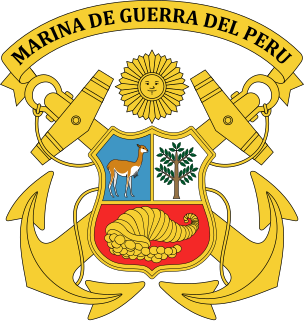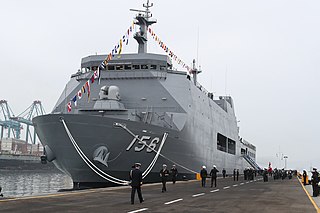
The Wasp class is a class of Landing Helicopter Dock (LHD) amphibious assault ships operated by the United States Navy. Based on the Tarawa class, with modifications to operate more advanced aircraft and landing craft, the Wasp class is capable of transporting almost the full strength of a United States Marine Corps Marine Expeditionary Unit (MEU), and landing them in hostile territory via landing craft or helicopters as well as providing air support via AV-8B Harrier II attack aircraft or F-35B Lightning II stealth strike-fighters. All Wasp-class ships were built by Ingalls Shipbuilding, at Pascagoula, Mississippi, with the lead ship, USS Wasp, commissioned on 29 July 1989. Eight Wasp-class ships were built, and as of June 2018, all eight are active.
A training ship is a ship used to train students as sailors. The term is especially used for ships employed by navies to train future officers. Essentially there are two types: those used for training at sea and old hulks used to house classrooms.
Pisco is a grape brandy produced in Peru and Chile.

The Lupo class is a class of frigates built by Cantieri Navali Riuniti (CNR) for the Italian Navy. Designed as multipurpose warships with emphasis on anti-surface warfare (ASuW), they have enjoyed some success in the export market, being acquired by the navies of Peru and Venezuela. A small run of a slightly updated version is known as the Soldati class.

BAPAlmirante Grau(CLM-81) was a De Zeven Provinciën-class cruiser in service with the Peruvian Navy. Completed for the Royal Netherlands Navy in 1953 as HNLMS De Ruyter (C801), she was acquired by Peru in 1973 and served as fleet flagship. Almirante Grau underwent a major modernization program between 1985 and 1988 during which she was fitted with new weapons and electronics. She was the last gun cruiser in service in any navy before being decommissioned on 26 September 2017.
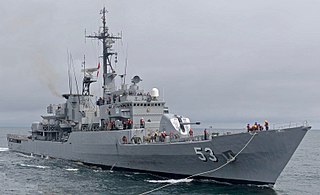
BAP Almirante Grau is the third out of four Carvajal-class frigates ordered by the Peruvian Navy in 1973 and originally named Montero. It was built by SIMA at Callao under license from the Italian shipbuilder Cantieri Navali Riuniti. As such, it was the first modern warship built in Peru. In late 2007 her flight deck was extended to allow ASH-3D Sea King helicopters to land and refuel, even though they can not be housed in the ship's hangar.

The Cannon class was a class of destroyer escorts built by the United States primarily for ocean antisubmarine warfare escort service during World War II. The lead ship, USS Cannon, was commissioned on 26 September 1943 at Wilmington, Delaware. Of the 116 ships ordered, 44 were cancelled and six were commissioned directly into the Free French Forces. Destroyer escorts were regular companions escorting the vulnerable cargo ships.

BAP Paita (DT-141) is the former-USS Walworth County (LST-1164), a Landing Ship, Tank leased from the US Navy for five years on 7 August 1984; recommissioned 4 March 1985; leased later extended to 1994.
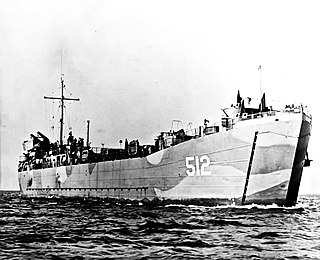
USS Burnett County (LST-512) was an LST-491-class tank landing ship built for the United States Navy during World War II. Named for Burnett County, Wisconsin, she was the only U.S. Naval vessel to bear the name.
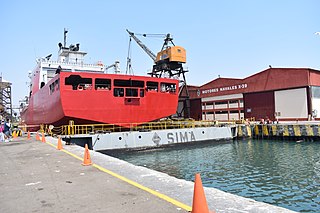
Servicios Industriales de la Marina S.A., well known as SIMA or SIMA PERU S.A., is a Peruvian shipyard that operates as a state owned company established under private law in 1950 pursuing the activities of the former Naval Factory founded in 1845, and continually extending its operational capacity, first to the shipbuilding which SIMA pioneered in South America and then to the greatest metalworking structures manufacture, contributing to the defense and socio-economic development of Peru. The SIMA principally serve the Navy of Peru as well as domestic and foreign private clients through a wide range of products.

USS Waldo County (LST-1163), previously USS LST-1163, was a United States Navy landing ship tank (LST) in commission from 1953 to 1970, and which then saw non-commissioned Military Sealift Command service as USNS Waldo County (T-LST-1163) from 1972 to 1973.
At least two ships of the Peruvian Navy have been named BAP Diez Canseco:
At least three ships of the Peruvian Navy have been named BAP Gálvez or BAP Teniente Gálvez:

BAP Abtao (SS-42) was a Abtao-class submarine of the Peruvian Navy.

USS ATR-31 was an ATR-1-class Rescue Ocean Tug of the United States Navy during World War II, and later the Peruvian Navy. Her fate is unknown.
At least two ships of the Peruvian Navy have been named BAP Castilla:
This page is based on this
Wikipedia article Text is available under the
CC BY-SA 4.0 license; additional terms may apply.
Images, videos and audio are available under their respective licenses.
